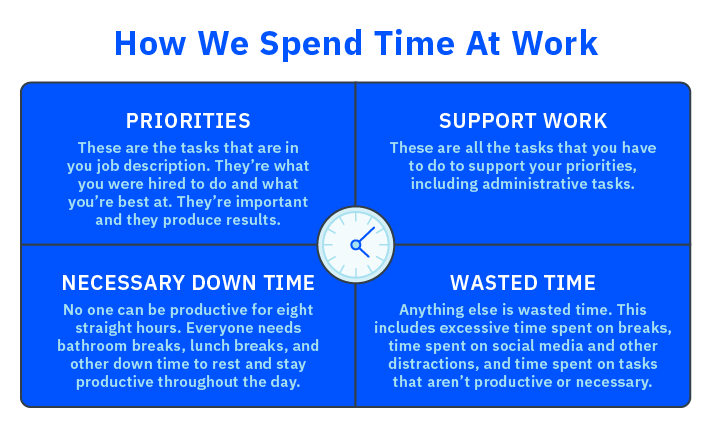It’s no secret that basically no one goes to the office and stays perfectly on task for eight straight hours, five days a week.
From social media notifications to pointless meetings, and long lunches to water cooler chats with other coworkers, a typical office workday can feel like a constant bombardment of distractions from the real work that needs to be done.
You’ll never be able to create a completely distraction-free workplace, but that’s not to say you can’t make some changes to cut down on some of the most common timewaster plaguing offices today. If your 2020 goals include eliminating barriers to efficiency in your office, you’ve come to the right place. These are 30 of the most common frivolous timewasters that can (and should) be eliminated.
“What a Waste of Time”
Think about the last time you said that phrase at work. Was it after a particularly long meeting your didn’t feel like you needed to be a part of? After a long stretch of administrative tasks that feel repetitive and pointless? Or after losing track of time scrolling away on Facebook at your desk?
To understand how to eliminate timewasters in the office, we first need to understand what tasks actually are a waste of time—and which ones just feel tedious but are actually needed. For that, let’s divide office tasks into four categories:

As you can see, not all the time you spend at work will feel like it’s 100 percent efficient or productive, and that’s OK in some cases, like when you’re doing support work or taking necessary down time. We’re going to focus on instances of actual wasted time, and what can be done to eliminate those.
All the Ways We Waste Time at Work (And What to Do About Them)
The most common office timewasters can be separated into three groups: Personal timewasters, Coworker timewasters, and Institutional timewasters.
Person Timewasters and How to Eliminate Them
Personal timewasters can range from bad work habits to theft of company time. Here are the most common ones, and what to do about them.
- Personal calls and texts. In 2020, everyone expects their family and friends to be reachable 100 percent of the time, even at work. It’s hard to enforce a blanket ban on personal calls and texts, since people have lives outside of the office and emergencies happen. But keeping mobile phones out of sight while at work (like in your bag or in a desk drawer) and only checking it on breaks is a good habit to start and encourage this year.
- Too-long lunches or breaks. Most companies have a policy that limits lunch and break times, and if yours doesn’t, it may be time to implement one. While it’s impossible to reduce all time employees will waste socializing or taking breaks, regular performance reviews can be a good way to hold people accountable for making their work time about getting work done.
- Chatting with coworkers. Coworkers who get along with one another create a better work environment and have higher morale. But if those friendly relationships get in the way of office efficiency, it’s not a bad idea to try to limit socializing to those predetermined, limited break times. If an office friend veers into small talk, change the subject back to work matters, or excuse yourself to head back to your desk.
- Social media. Unless the job requires social media, there’s not really any reason for employees to be able to access it. In fact, social media has been found to cost companies an estimated $650 million each year in lost productivity. Blocking access to sites like YouTube, Facebook, and Reddit at the office is common and can definitely help cut down on wasted time.
- Outside interests (gaming, surfing, etc.). When employees spend their time at the office playing games, surfing the web, or otherwise pursuing outside interests, it can severely impact their productivity. Try to make sure everyone in your office has meaningful work to do that keeps them engaged, so their motivation comes from their true desire to do the work and do it well.
- Slow work pace. There are a lot of reasons for someone to be working at too slow a pace. This is another instance where performance reviews can come in handy. Bring up the slow pace of work and see if the employee can identify a reason for it.
- Distractions. Offices are full of distractions. Offering a conference room or some offices as spaces where people can go to have quiet, distraction-free periods of work time can help. It can also help to cut down on distracting visitors to the office with a visitor management system.
- Outside distractions. Not all distractions happen inside the office—they could be from an employee’s life outside of work. It’s never a bad idea to have support systems in place for employees who struggle with pressures from outside of work keeping them from doing their work.
- Lack of systems knowledge. Wasted time could very well come from employees just not knowing everything they need to. Providing thorough training and an office environment that’s open for people who ask for help will combat this.
- Clutter. It can be tough to work in a messy environment. Encourage workers to keep their desks clean and tidy.
- Being late. Frequent tardiness can also cut into productive work time. Make it clear when everyone is expected to be at work. Post meeting times well in advance so everyone can plan to be there on time.
- Not following instructions. When tasks are done incorrectly, it can eat up a lot of work time. Make instructions clear, and make sure workers have the opportunity to ask questions or ask for help.
- Multitasking. Many people think they can multitask, but research shows our brains are actually wired to only work on one thing at a time—attempts at multitasking caused a 40 percent loss of productivity in one study. Encourage employees to dedicate their time and attention to finishing one task before moving on to the next.
- Repetitive, time-consuming tasks. Every job comes with some of these, but they don’t necessarily have to waste so much employee time. Some tedious and administrative work can be automated to remove those time-sucking tasks from employees’ plates.
Ultimately, a lot of personal timewasters are difficult to control at the management level. Writing an office policy limiting how much time workers can spend chatting at the watercooler will never be effective. The best bet for eliminating personal timewasters is doing your best to hire skilled, motivated workers, and then giving them plenty of autonomy and meaningful work so their motivation will be intrinsic.
What you have more of an ability to eliminate, though, are coworker and institutional timewasters, like the ones below.
Coworker Timewasters and How to Eliminate Them
We can control ourselves, but we can’t control the people around us. That’s why a lot of coworker timewasters are unavoidable. There are ways to mitigate the waste, however, when you encounter these common coworker timewasters.
- Emails. Email tag and back-and-forth can eat up a ton of company time, so establishing protocols for internal communications, like email, can help cut down on the noise and the wasted time. And instead of constantly checking email all day long, designate a few times a day to respond.
- Overcommunication. It used to be that when coworkers needed to talk to one another, they’d have to do it on the phone or in person. Now, many of those office discussions happen electronically, which can lead to a deluge of emails, instant messages, and chat notifications. Before reaching out to a coworker, consider whether this conversation can be handled quickly via the office chat, or whether you should find some in-person time.
- Late meeting starts. Meetings already eat up a ton of office time, so if they don’t start on schedule, you’re looking at a lot of wasted hours adding up. Make sure everyone knows the meeting start time and has all the necessary materials well ahead of time. A meeting management solution can help with this.
- Unnecessary requests. Sometimes coworkers make requests to the wrong people, or for work that doesn’t need to be done. Making sure every worker has clearly defined responsibilities can help mitigate time wasted on unnecessary requests.
- Unclear communication. Not everyone is a perfect communicator all the time. Fostering an office environment with open communication, where people can ask questions, or choose whether to communicate electronically or face-to-face, can help cut down on time wasted because of miscommunication.
- Mistakes. Everyone makes mistakes sometimes. There’s not much you can do about it other than make sure your employees have the best training and support you can offer.
- Interruptions. Like distractions, interruptions are just something that are bound to happen sometimes in an office. Having designated areas for people to go when they need to do distraction-free work and are not to be interrupted can help.
Not all timewasters happen on an individual level, though. Institutions are just as guilty of wasting their workers’ time.
Institutional Timewasters and How to Eliminate Them
A huge frustration for workers is when their time is wasted at work, and it’s because of an institutional issue they can’t even control. Definitely do what it takes to eliminate these.
- Bad meetings. When meetings are poorly run, go off topic, include people who don’t need to be there, and have other problems, tons of company time gets wasted. A recent study found that 63 percent of corporate meetings had no agenda, and unproductive meetings cost companies $37 billion annually. If your company struggles with keeping meetings from being timewasters, you need a meeting management solution ASAP.
- Disorganization. Plenty of work time is wasted when disorganization causes communication breakdown, financial troubles, and other kinds of chaos. And then there’s the times workers can’t find information they need—CMS Wire found that workers spend an average of 36 percent of their day searching for and consolidating information. If your organization struggles with miscommunication, overdue tasks, financial losses, and other signs of a disorganized workplace, 2020 is your year to get in gear. Try a task management system like Trello or Asana to stay on top of it all and keep relevant information where employees can locate it quickly.
- Tool trouble. Whether it’s that you’re using the wrong tools, or you have too many tools, you might be facing wasted office time because of tool trouble. In 2020, do an audit of the tools your office uses (and doesn’t), and gather feedback from employees about what tools they actually need to be more productive.
- Equipment problems. Keeping company equipment well-maintained and in good working order will help eliminate lost time from when things just aren’t working properly.
- Unclear job descriptions. When workers don’t know exactly what they’re supposed to be doing at work, naturally, they won’t get much work done. Make sure everyone has a clear job description and knows what they should be working on.
- High employee turnover. Research shows that high organizational turnover rates waste a lot of money and time. Avoid seeing a lot of turnover by making your organization a place people want to work. Offer competitive salaries and benefits, promote a healthy work-life balance, and give people meaningful work that contributes to a higher goal. These are all proven morale boosters that entice people to stay loyal to their companies.
- Bad processes. There’s always room for improvement, and office processes are no exception to that. To cut down on time wasted because of ineffective processes, be constantly open to better understanding how employees are spending their time and creating systemic improvements to help them stay on task and productive.
- Major changes. Change is inevitable, but it can also account for lost productivity in offices. If your company navigates any major changes, be transparent with all employees about the process so everyone knows what’s happening and how they fit into it—and can get right back to getting work done.
-
Legal problems. Legal problems can tie up a lot of office time, and they’re not always unavoidable. Working with professionals like lawyers and accountants can help ensure everything your company does is on the up and up, avoiding these particular timewasters.
Let’s Reduce Wasted Office Time In 2020
Some wasted time is inevitable. People will get off task. They’ll chat with each other. They’ll daydream. Mistakes will happen. Offices aren’t perfect places, and they never will be. As hard as we try to make our office perfectly efficient machines, it won’t ever happen.
What we can do is try to remove barriers to productivity so our workers can spend their time doing important, meaningful work that makes them happy. At the end of the day, that’s the best any office can do, and that should be our real efficiency goal for 2020.



